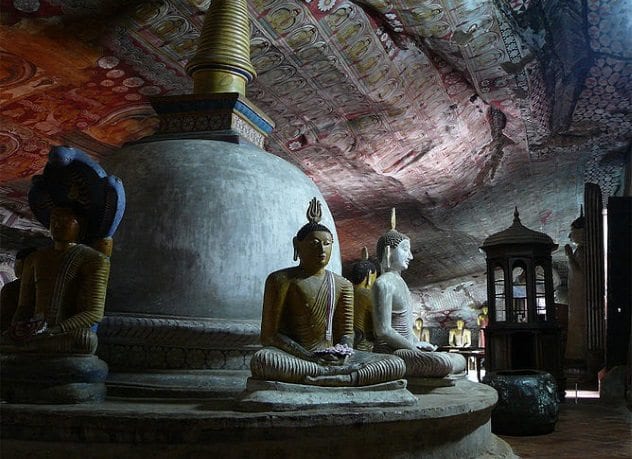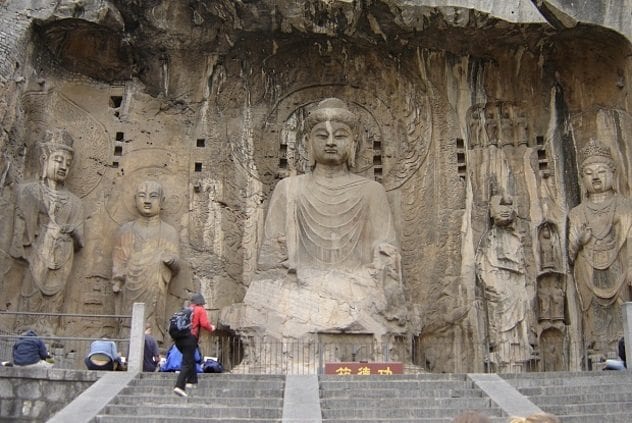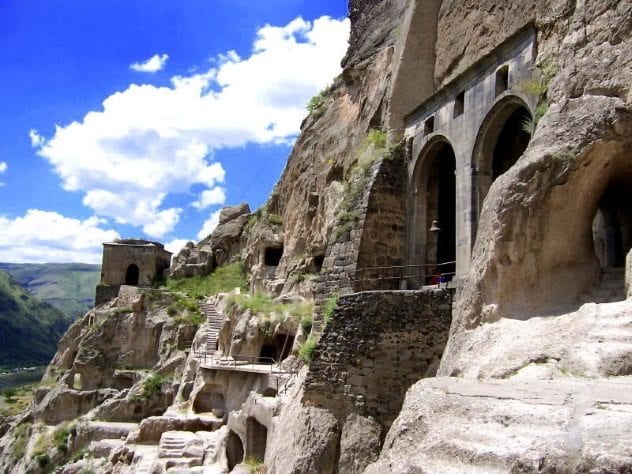 Humans
Humans  Humans
Humans  Animals
Animals 10 Species That Refused to Go Extinct
 Weird Stuff
Weird Stuff 10 Weird Things People Used to Do at New Year’s
 Our World
Our World 10 Archaeological Discoveries of 2025 That Refined History
 Weird Stuff
Weird Stuff 10 Fascinating Facts You Might Not Know About Snow
 Miscellaneous
Miscellaneous Top 10 Things Crypto Was Supposed to Change & What Actually Did
 History
History 10 Huge Historical Events That Happened on Christmas Eve
 Music
Music 10 Surprising Origin Stories of Your Favorite Holiday Songs
 History
History 10 Less Than Jolly Events That Occurred on December 25
 Weird Stuff
Weird Stuff 10 Funny Ways That Researchers Overthink Christmas
 Humans
Humans 10 Unsung Figures Behind Some of History’s Most Famous Journeys
 Animals
Animals 10 Species That Refused to Go Extinct
 Weird Stuff
Weird Stuff 10 Weird Things People Used to Do at New Year’s
Who's Behind Listverse?

Jamie Frater
Head Editor
Jamie founded Listverse due to an insatiable desire to share fascinating, obscure, and bizarre facts. He has been a guest speaker on numerous national radio and television stations and is a five time published author.
More About Us Our World
Our World 10 Archaeological Discoveries of 2025 That Refined History
 Weird Stuff
Weird Stuff 10 Fascinating Facts You Might Not Know About Snow
 Miscellaneous
Miscellaneous Top 10 Things Crypto Was Supposed to Change & What Actually Did
 History
History 10 Huge Historical Events That Happened on Christmas Eve
 Music
Music 10 Surprising Origin Stories of Your Favorite Holiday Songs
 History
History 10 Less Than Jolly Events That Occurred on December 25
 Weird Stuff
Weird Stuff 10 Funny Ways That Researchers Overthink Christmas
10 Mysterious Cave Temples
Caves resonate with humans on deep spiritual level. They not only provided shelter to our ancestors, but they were the sites of the first religious rites. It’s no wonder that these structures remain powerful sources of spirituality. Enigmatic cave temples exist around the world. While many are ancient, their modern counterparts suggest that worshiping in caves will endure indefinitely.
10 Cave Church Of The ‘Garbage People’

The Zabbaleen are a Coptic Christian minority within Egypt. Their name means “garbage people.” Once Upper Egyptian farmers, the Zabbaleen realized that scavenging through waste was more profitable after they migrated to Cairo. In 1969, the capital’s governor decided to move all the Zabbaleen to “Garbage City,” at the base of Mokattam Cliff. They built a church to satisfy the community’s spiritual needs, but it burned down in 1976. Afterward, they carved a church from the cliff’s caves.
Named after a tenth-century craftsman, the Monastery of St. Simon is the largest church in the Middle East. The church is built into a preexisting, sloping cave and can house 20,000. Smaller churches have been built into surrounding caves. “Garbage City” now has a population of about 30,000 inhabitants, and hundreds of thousands of Christians make pilgrimages to the Cave Church of St. Simon each year.
9 Barabar Cave Temples

The Barabar Caves contain the oldest rock-cut temples in India. Dated to the third century BC, these caves are so ancient that experts believe them to be the legendary “Gorathgiri” mentioned in sacred Hindu texts. The temples came to the attention of the Western world in 1868 through a description by Alexander Cunningham. According to legend, King Ashoka donated the Barabar Caves to the Ajivika sect, who were contemporaries with the Buddha.
Barabar Cliff is 200 meters (656 ft) long and contains four caves. The polish and symmetry of the caves reflect a mysterious expertise in masonry. The unique architecture results in an ever-changing echo that lasts several seconds. Experts believe that the chambers were polished to a specific point to achieve this effect. Three of the caves contain two chambers. The first is larger and is believed to have been a gathering space. The second is smaller and is believed to have served as an inner sanctum.
8 Cave Of The Python God

In Botswana’s Rhino Cave, archaeologists discovered evidence of Homo sapiens‘s earliest religious ritual. Experts believe the San people used the cave to worship a python god as far back as 70,000 years ago—30,000 years earlier than previously thought. Discovered in the 1990s, the cave contains a natural rock formation that resembles the head of a python. The stone is 6 meters (20 ft) long by 2 meters (6.5 ft) high and is covered with intentional scratch marks that experts believe were meant to be scales.
Anthropologists have long believed that symbolic thinking associated with religion emerged around the time of humanity’s migration out of Africa. There was an explosion of symbolic representations beginning around 45,000 years ago. However, the presence of specialized bone tools and red ocher suggest that the people of Rhino Cave exhibited this thinking thousands of years earlier.
7 Cave Temples Of Dunhuang

The Cave Temples of Dunhuang were a must-stop location on the Silk Road between the fourth and 14th centuries. Filled with immaculate Buddhist art, the temple complex is made up of the 450 Mogao Caves. Located on the edge of China’s Gobi Desert, the inaccessible caves were once a hot spot. The location was just as significant as a marketplace as it was for being a shrine.
Archaeologists have discovered documents containing Jewish and Christian prayers in the cave temples, revealing how far religious ideas spread along the Silk Road. The most significant discovery in the caves has been the “Diamond Sutra.” Printed with woodblocks in AD 868, this work predates the invention of Guttenberg’s printing press and is believed to be the oldest printed book in the world. Once shipping shifted to the sea, the site was largely abandoned.
6 Gellert Hill Cave

On Gellert Hill above Buda in Budapest, a cave church exists that was once home to a hermit monk. The Order of St. Paul the First Hermit runs the cave church and built the chapel out of the original hermitage in 1926. They have not always had good relationships with the government. In 1951, Communist leaders accused the entire order of treason. The abbot was executed, and the rest of the monks were forced into labor camps. Afterward, they sealed the cave church with 2.4 meters (8 ft) of concrete.
Since the cave was reopened in 1989, all of the church’s surfaces are now concrete and faux-cave. Gellert Hill is known for its replica of the Black Madonna of Czestochowa, Poland, a figurine that has turned black for unknown reasons. The Pauline monks of this cave church have venerated the replica for centuries.
5 Tomb Of The Holy Sepulchre

In October 2016, archaeologists in Jerusalem’s Church of the Holy Sepulchre revealed Jesus’s tomb for the first time in centuries. According to scripture, Jesus was laid to rest on a “burial bed” cut from the side of a limestone cave. Three days later, his remains disappeared. The area believed to contain Jesus’s burial site is now located in the Edicule, or “little house.” Helena, the mother of Emperor Constantine, first identified the site in AD 326. A stone slab has covered the entrance to the tomb since at least 1555.
Excavations showed that the burial bed which supposedly held Jesus was still intact and engraved with a cross. They also uncovered the original limestone cave walls within the Edicule. The tomb’s location outside the walls of Jerusalem fits with Jewish burial tradition. Its location near Golgotha, where Jesus was executed, also lends some credence to the legends of his death.
4 Golden Temple Of Dambulla

The Golden Temple of Dambulla cave complex has drawn pilgrims to Sri Lanka’s interior for 22 centuries. While there are over 80 known caves in the area, the majority of statues and paintings appear in a network of five caves. These temples contain 153 statues of Buddha, three statues of Sri Lankan royalty, and four statues of gods and goddesses. Dated to the third century BC, the complex is one of the most ancient sites in Sir Lanka and still functions as a monastery.
The Golden Temple is the best-preserved cave complex on the island. However, it is not completely original. There were major renovations in 1190 and again in the 18th century. Buddhist murals cover 2,100 square meters (22,600 ft2) of wall space. Archaeologists believe ancient Sri Lankans lived in the caves long before Buddhism arrived on the island. Skeletons dating back as far as 2,700 years have been unearthed in the vicinity.
3 Longmen Grottoes

In March 2016, the Longmen Grottoes cavern temple opened to the public for the first time in over six decades. The temple, carved into Dongshan Mountain, dates back to AD 624–705, during the reign of Wu Zetian. China’s only empress was also an ardent Buddhist. The Longmen Grottoes are located along both sides of the Yi River near the ancient capital of Luoyang. The complex is comprised of more than 2,300 individual caverns and contains 110,000 Buddhist figurines.
The cave temple suffered serious damage during the Chinese Cultural Revolution. The statue in the main chamber was so damaged that it has been replaced by a copy. The temple is known for its collection of 29 relief statues depicting arhat monks on their quest for Enlightenment. They date back to the Tang dynasty, between AD 618 and 907. These depictions have revealed a wealth of information on ancient clothing and instruments.
2 Salt Cathedral Of Zipaquira

The town of Zipaquira, Colombia, has a church built 200 meters (656 ft) underground in the depths of a salt mine. The mine is the largest deposit of rock salt in the world. The Muisca people were the first to exploit this natural resource and turn it into a profitable trade. These same mines were used to finance Simon Bolivar’s quest to liberate Colombia from the Spanish.
The cathedral itself isn’t old; it opened in 1995, a project which required the removal of 250,000 tons of rock salt. It’s the second cathedral to be built, after the one was deemed unsafe. The mine also contains a salt waterfall, 13 relief carvings of the Stations of the Cross, and a giant crucifix. Hundreds of colored lights illuminate the walls and cause the salt the shimmer.
1 Vardzia Cave Monastery

In the 12th century, the Mongols unleashed their wrath upon the medieval kingdom of Georgia. Queen Tamar ordered the construction of an underground sanctuary to avoid these marauders. In 1185, the Georgians carved an underground fortress directly into the solid rock of Erusheli Mountain. The structure contained 6,000 apartments over 13 levels, a throne room, and a massive church with an external bell tower.
The Vardzia Cave complex was self-contained. Crops were grown on irrigated terraces on the outside of the mountain. Inhabitants drew spring water from tunnels deep within the structure. One underground well was known as “Tamar’s Tears.”
The Vardzia Cave Complex was strong enough to withstand the Mongols, but Mother Nature was another story. In 1283, an earthquake destroyed nearly three quarters of the city. The monastery clung on until 1551, when it fell to a Persian onslaught. Seven Orthodox monks still tend to the ancient site.
Abraham Rinquist is the Executive Director of the Winooski, VT, branch of the Helen Hartness Flanders Folklore Society. He is the coauthor of Codex Exotica and Song-Catcher: The Adventures of Blackwater Jukebox.








